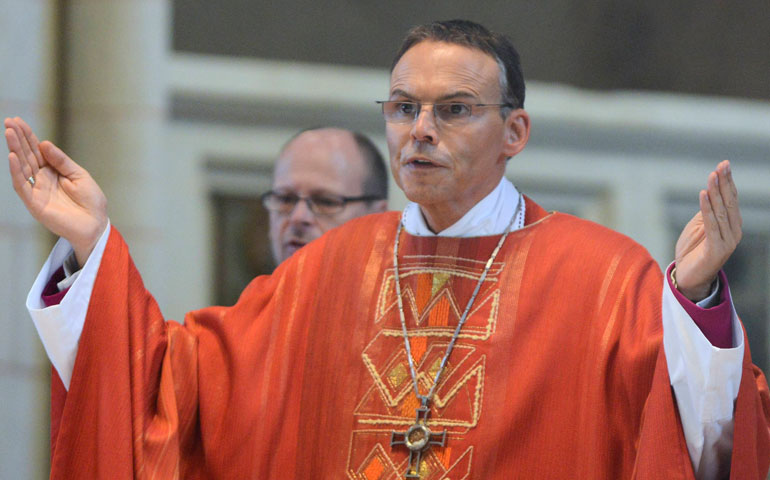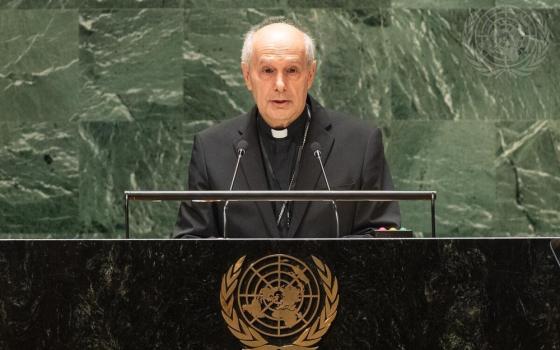
Bishop Franz-Peter Tebartz-van Elst (CNS)
In his first clear disciplinary move, albeit a gentle one, to bring recalcitrant bishops into line with his demand that they spurn the "psychology of a prince," Pope Francis on Oct. 23 assigned German Bishop Franz-Peter Tebartz-van Elst an unspecified period of leave outside his Limburg diocese.
Tebartz-van Elst had become infamous in Germany and beyond as the "bling bishop," so dubbed because of spending an estimated $42 million on remodeling his diocesan center and residence, including $1.1 million for garden landscaping and even $22,000 for a bathtub. He's also drawn charges of strong-arm leadership, allegedly bypassing consultative bodies in the diocese.
According to media reports, Tebartz-van Elst may spend his break in a Benedictine monastery in Bavaria. Though a Vatican announcement did not address his future, many observers believe it's improbable he'll ever return to head the church in Limburg.
In general, German reaction seems broadly positive -- both for the fact that Tebartz-van Elst was removed, and for the relatively soft landing Francis engineered.
A spokesman for the liberal Catholic reform group We Are Church, which is often critical of church authority, described the way Francis allowed Tebartz-van Elst to exit without immediately requiring his resignation as an expression of "great mercy."
The move came on the heels of an investigation in September by Italian Cardinal Giovanni Lajolo, formerly the Vatican's top diplomat and head of the Vatican City State. In late October, Tebartz-van Elst traveled to Rome along with Archbishop Robert Zollitsch, president of the German Bishops' Conference, for a meeting with Francis.
The Oct. 23 Vatican statement said a commission set up by the bishops' conference, in tandem with local leaders, will continue to review spending on the renovation project. Francis named the new vicar general of Limburg, Msgr. Wolfgang Rösch, as interim administrator.
Msgr. Helmut Wanka, a longtime official of the diocese, said during an Oct. 23 press conference he doubts Tebartz-van Elst will be back.
"If a priest were in the situation our bishop now finds himself in, I would arrange some time away for him, and after his break I'd give him a new beginning in another parish," Wanka said. "That usually helps bring some perspective."
Fr. Günther Geis, dean of the cathedral chapter in Limburg, was blunter: "We need to make a new start with a new bishop."
Speaking on background, a Vatican official told NCR Oct. 26 that the question of what Tebartz-van Elst's eventual role might be hasn't been decided. He said Francis opted for a sabbatical rather than asking for the bishop's resignation in part because of his age -- Tebartz-van Elst will be 54 Nov. 20.
"The feeling is that if he can turn things around, he could still give decades of service to the church, even if it's somewhere else," this source said.
Though rare, the decision to give a troubled bishop time away is not unprecedented. In January 2008, Pope Benedict XVI granted Bishop Donald Pelotte of Gallup, N.M., a one-year leave of absence, following serious injuries that Pelotte attributed to a fall but others believed indicated a serious beating.
In that case, Pelotte never returned to lead the diocese. He resigned in April 2008 and died in January 2010.
Even before the cause célèbre over spending broke out, Tebartz-van Elst had already faced blowback. In March 2012, a group of Limburg priests accused him of being "authoritarian," while in 2011 more than 4,000 people signed a petition opposing his administration.
Those difficulties appeared to have been smoothed over in mid-September, following the review conducted by Lajolo. In a joint statement with other local leaders, Tebartz-van Elst pledged "to make regular and reliable use of the advisory bodies" in the diocese.
He also promised transparency with regard to spending on the renovation project, including an independent audit under the auspices of the German Bishops' Conference. As disclosures of cost overruns mounted, however, pressure continued to build for Tebartz-van Elst to exit the scene.
Even outside the diocese, his troubles may not be over. Tebartz-van Elst faces possible fines for allegedly giving false testimony in affidavits to a court in Hamburg, after he tried to sue the German magazine Der Spiegel for reporting in 2012 that he flew first class to India on a trip to serve the poor. Prosecutors in Limburg have also said that they're looking into charges of misappropriation or embezzlement related to his use of church funds.
While Tebartz-van Elst's fate remains up in the air, leaders in the Limburg diocese are now debating what to do with the St. Nicholas Diocesan Center, the 2,000-square-meter complex that includes the bishop's residence.
According to an Oct. 27 report in Der Spiegel, various possibilities are being floated for the complex, including turning it into a refugee center, a soup kitchen and residence for the homeless, or a tourist attraction.
Some locals believe such uses would be more in the spirit not only of Francis, but also the former bishop of Limburg, Frank Kamphaus, who moved into a small apartment on seminary grounds in the 1980s and '90s while allowing a family of Eritrean refugees to live in the bishop's residence.
Most observers believe it's unlikely that any future bishop will move back into the residence, given its association with the controversies surrounding Tebartz-van Elst.
Der Spiegel quoted a member of the cathedral chapter in Limburg as saying that whatever happens to the facility, one thing is clear: "The stench of money is gone," he said.
[John L. Allen Jr. is NCR senior correspondent. His email address is jallen@ncronline.org.]




